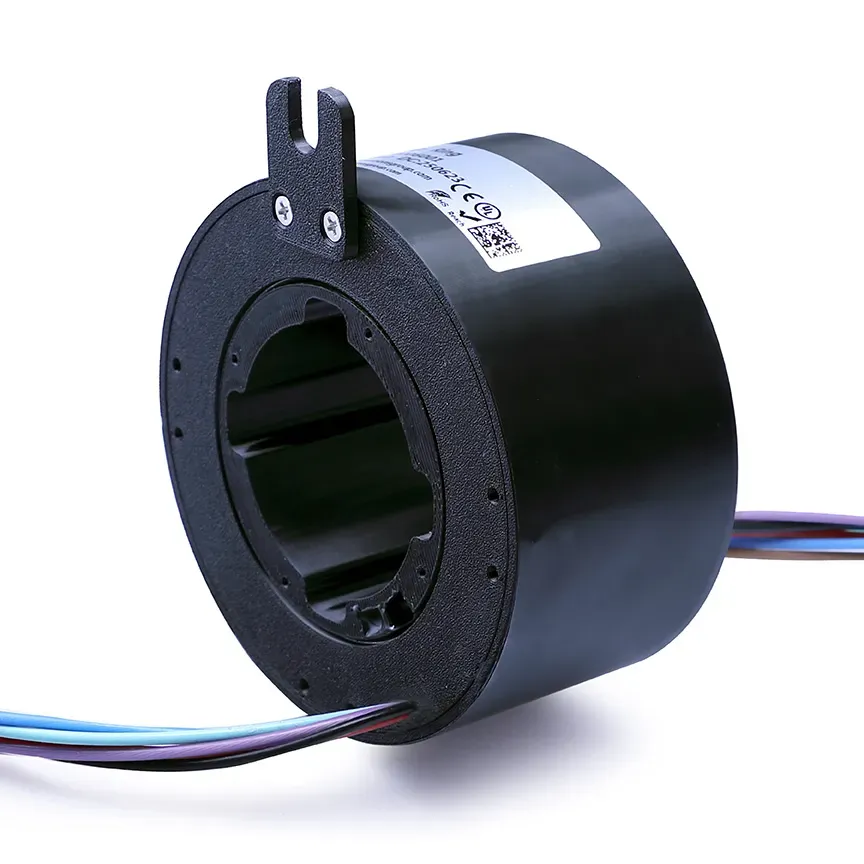New Application: Through hole Slip Rings in Automated Warehouses: Reducing Downtime
BY NBG
 2025-11-11
2025-11-11
VIEWS: 118
New Application: Through-Hole Slip Rings in Automated Warehouses: Reducing Downtime
Introduction
Automated warehouses are the heart of today's eCommerce and help store products and update the sellers about the inventory. The regular updates with the timely management of stocks are of prime importance for the retailer. A slight failure due to mechanical or data transmission can disturb the whole supply chain system.

Through-hole slip rings play a crucial role in the power and signal transmission among the rotating arms of robots or other components. With minimal downtime, sellers can track their inventory and get more confidence in the system. Today, we will discuss how through-hole slip rings help in the automated warehouse management system and understand different applications.
What Are Through-Hole Slip Rings?
Through-hole Slip rings are simple devices with comprehensive functionality and crucial tasks. They transmit the power and signals from stationary components to the rotating ones of a machine and ensure a next-level transmission experience.

Why are they called through-holes? The logic is straightforward. They have a central hole through which shaft or hydraulic tubes can pass. There are a few characteristics of a through-hole slip ring.
●The rotating contact mechanism involves brushes and rings.
●Center bore is ideal to accommodate mechanical mounting or other components.
●It is preferred for devices with 360° continuous rotation, such as rotary tables or robotic joints.
Challenges In Automated Warehouses
Automated Warehouses are the storehouses where consumers or retailers store their products. Compared to a traditional warehouse, an automated one features robots and other tools that automatically manage inventory and update the system. However, there are a few human engineers also involved.
Such a system often has the following challenges.
Need for continuous uptime.
Automated warehouses have to operate 24/7 to meet demand. There are continuous updates in the system as the sales channels are active all the time, and shipping occurs out of warehouses. Any disruption in power or signal transmission blocks the workflow and causes headaches for the users.
Do you know the results of downtime?
●Product packaging and branding are late.
●Shipping occurs late, leading to an impact on seller performance.
●There is a loss of business for the retailers.
Complex rotational systems
Since we are talking about the automated warehouses, robots are working and managing the inventory. Their rotating arms require the proper motion. Cranes lift the pallets and store them. Rotating scanners require a through-hole slip ring for the power transmission.
Without data supply or strong signals, it is challenging to manage all the tasks. Even if one component, such as scanners, fails to work, the result will be total failure in the supply chain system.
Wear and tear from repetitive motion.
If you compare the traditional warehouses with the automated ones, humans get fatigued while robots don't. It is a plus point, but at what cost?
Repeated twisting and bending of cables increases mechanical stress and results in cable failures. Frequent replacements can elevate maintenance needs and cause downtime.
Limited space and high-speed data requirements
Modern systems have one essential goal— compactness. Whatever machines or tools you deploy, they should be compact and must not take up more space.
Moreover, their correlation requires a constant data supply. Therefore, you have to work in a limited space but with real-time data transmission.
How Through-Hole Slip Rings Help Reduce Downtime
Once you know the problems and challenges of the automated warehouses, it is time to understand how the through-hole slip rings make a perfect place here.
Continuous Power And Signal Transfer
Through-hole Slip rings are designed to handle higher bandwidth data and transmit it through the rotating components continuously.
There are no loose connections or disruptions of data, leading to constant communication between the different parts of a warehouse.
Reduced Cable Wear
Once you have the through-hole slip rings installed, there is no need to worry about the cable twisting. It is because there are no more headaches from wear and tear.
It leads to reduced cable wear and increases the reliability of different components. You can reduce the replacement and maintenance costs.
Compact Design
If you want a compact design, it already is. How? The hollow shaft design of through-hole slip rings allows for efficient space usage. Other components, such as hydraulic hoses and mechanical rods, can pass through the center and save space.
Through-hole Slip rings are ideal for those machines that have limited space.
Low Maintenance And High Durability
Through-hole Slip rings are already reigning the industry due to their weather-resistant, waterproof, and corrosion-resistant features. They are designed to withstand millions of revolutions and ensure a long life under the stressful conditions.
Key Features to Look For in Warehouse Slip Rings
When purchasing the through-hole slip rings, you should look for the following crucial features.
High RPM Capability
High RPM capability allows for perfect work under stress conditions and is ideal for high-speed robotic arms and quick storage tasks. There is no degradation and signal loss in such cases.
Mixed Signal/Power Handling
Your through-hole slip ring should carry power, control signals, Ethernet, CANbus, or other data protocols simultaneously.
It should be compatible with complex automation tasks and handle integrated sensors and actuators.
Sealed Housing
Sealed housing means better protection. So, you can't miss it. Housing should be made of robust material and have an IP-RATED waterproofing and weatherproofing to avoid dust and dirt from entering the components and slowly destroying them.
Low electrical noise
Through-hole Slip rings should have no electromagnetic interference and avoid all other types of electrical noise. It keeps the signal integrity and helps transmit power flawlessly.
Lightweight And Compact Form Factor
You might have a compact system and want to maintain the space occupation. Go for the lightweight and compact form factor, saving extra space and keeping you onboard with the portability features.
Application Examples in Warehouse Automation
Through-hole slip rings are ideal for various components in the automated warehouses. Here is the list of applications.
Robotic picking arms
Through-hole Slip rings enable 360° rotation for grippers and arms without cable entanglement.
It also confirms the power and signal continuity to end-effectors and sensors, helping operate the system flawlessly.
Conveyor belt rotating joints
Slip rings are part of the rotary junction where conveyor belt joints change direction. They prevent cable fatigue and maintain efficient material flow through the functioning mechanisms.
Vertical carousel systems
Slip rings are part of the rotating storage/retrieval carousels. They help maintain the movements and ensure smooth operations of motors, brakes, and sensors.
AS/RS cranes and turntables
Cranes and turntables can also use the slip rings for various tasks. For example, the crane has rotary parts that need power transmission. It is the slip ring that decreases the rotation fatigue, causes minimal maintenance, and improves the work efficiency.
Rotating platforms for sorting or scanning systems
Barcode scanning stations and sorting platforms also require movement. Thanks to the slip ring that allows free movement without bending or twisting and wearing out of the components.
Conclusion
Through-hole Slip rings can minimize downtime and ensure a timely running of a warehouse. They optimize and help make a difference.
When selecting the through-hole slip rings, you should consider the quality and durability. Work with those suppliers who feature standardized through-hole slip rings!









